If there’s a current reigning champion in the vegetable world, it’s definitely cauliflower. It’s incredibly easy to cook and soaks up seasoning like a boss! On its own – prepared simply and perfectly – we love cauliflower just the way it is. Learn our favorite methods for cooking cauliflower, from seasoned oven roasted cauliflower to crisp tender Instant Pot cauliflower, and everything in between.
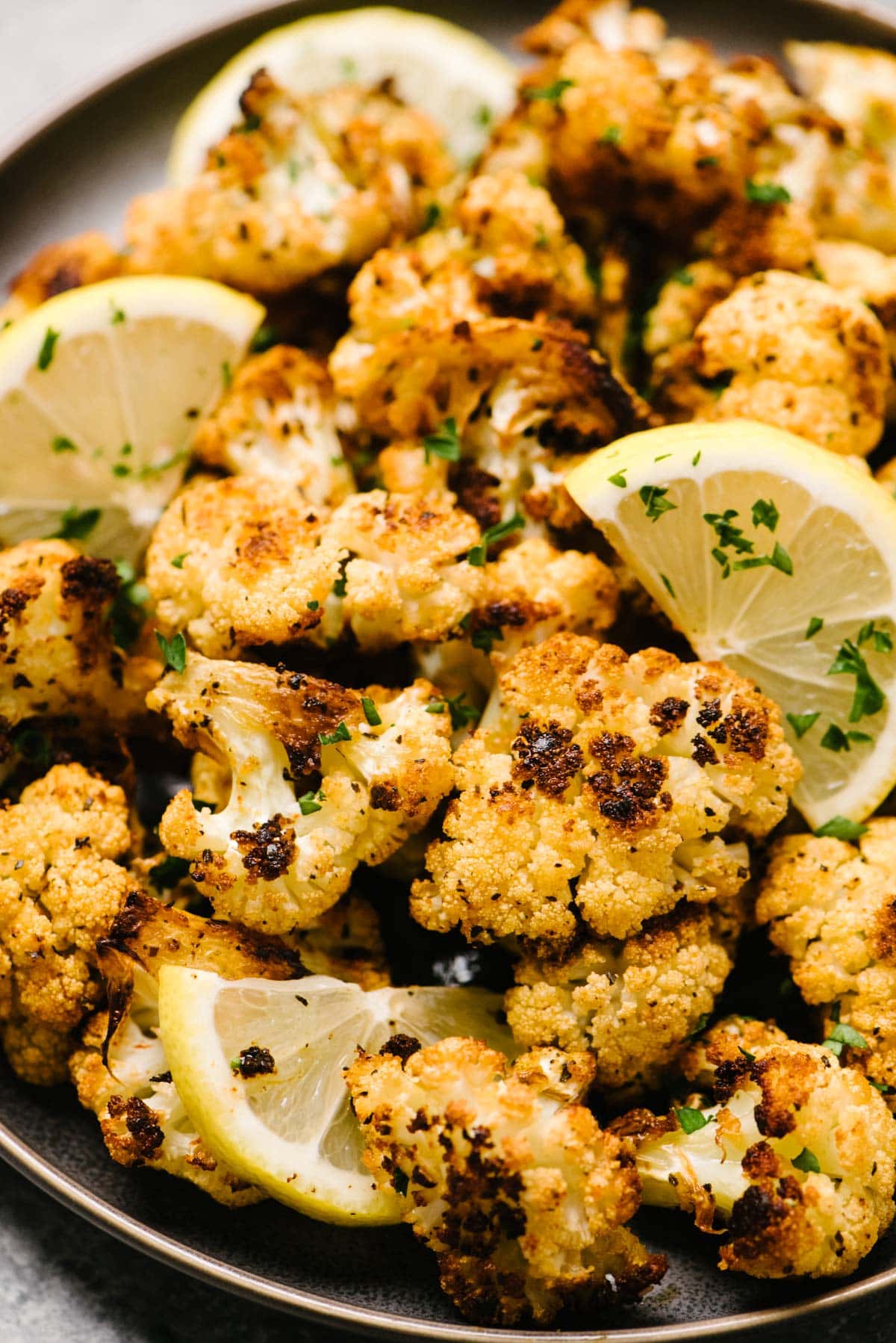
Jump to:
Once regarded as the white-headed stepchild of the crudité platter, cauliflower now appears to be the heir apparent to the vegetable kingdom crown. This humble representative of the Brassica family (also home to broccoli, cabbage and Brussels sprouts) is found – in one form or another – at kitchen tables everywhere now. It’s even become the carb-conscious darling of the fast-casual restaurant scene, landing itself in everything from pizza crusts to power bowls.
While there seem to be a million iterations, we’re here today to celebrate cauliflower “as-is”. These beginner cooking methods highlight its nutty, sweet, earthy flavor.
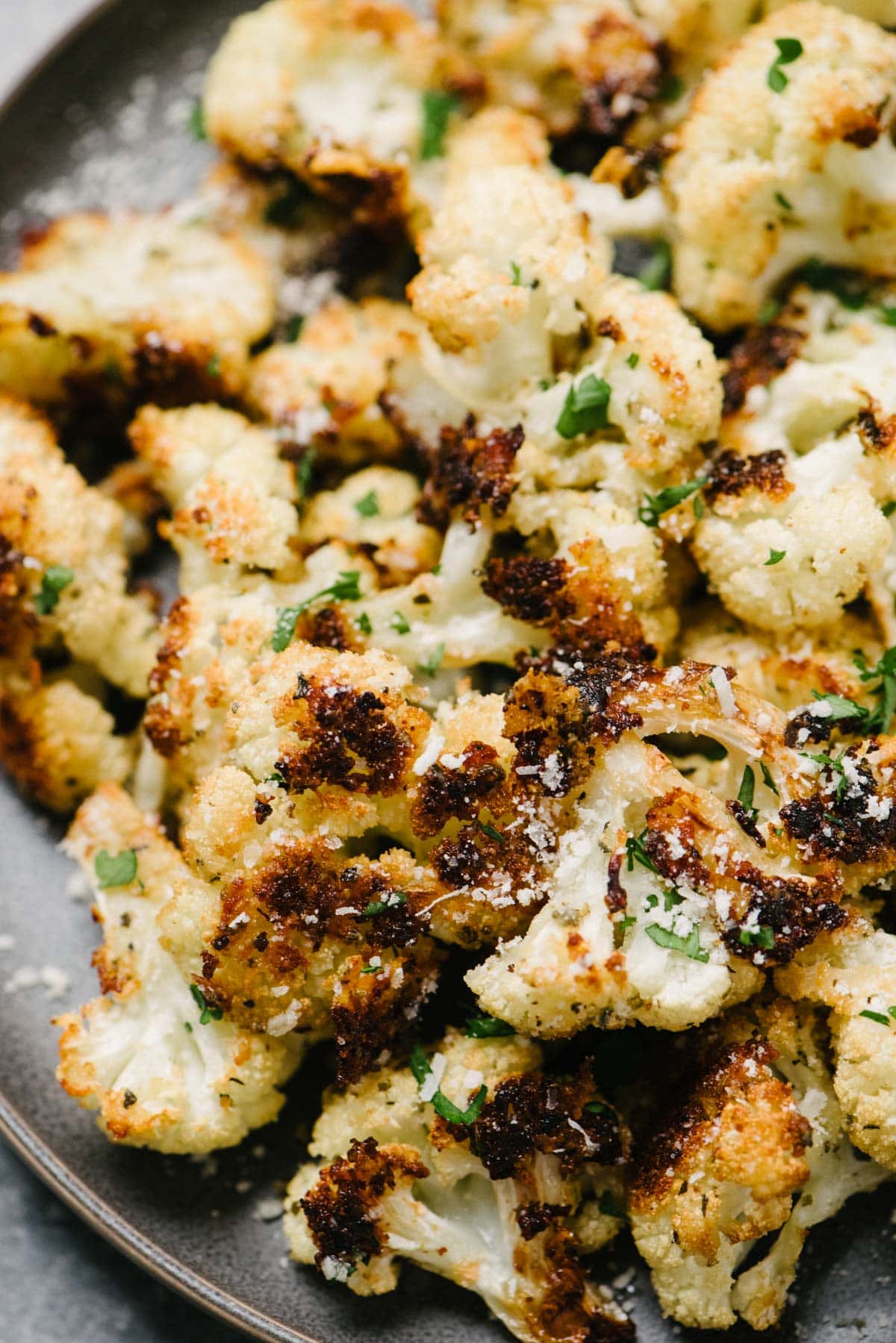

How to Cut Cauliflower
If I may be so bold – when it comes to cutting up a head of cauliflower, you might be doing it wrong. No judgement – I did it wrong for years! Here’s my painless method for trimming a head of cauliflower with very little mess, very little waste, and perfectly sized florets for any use you can imagine.
For a very detailed tutorial, see the full post How to Cut Cauliflower.

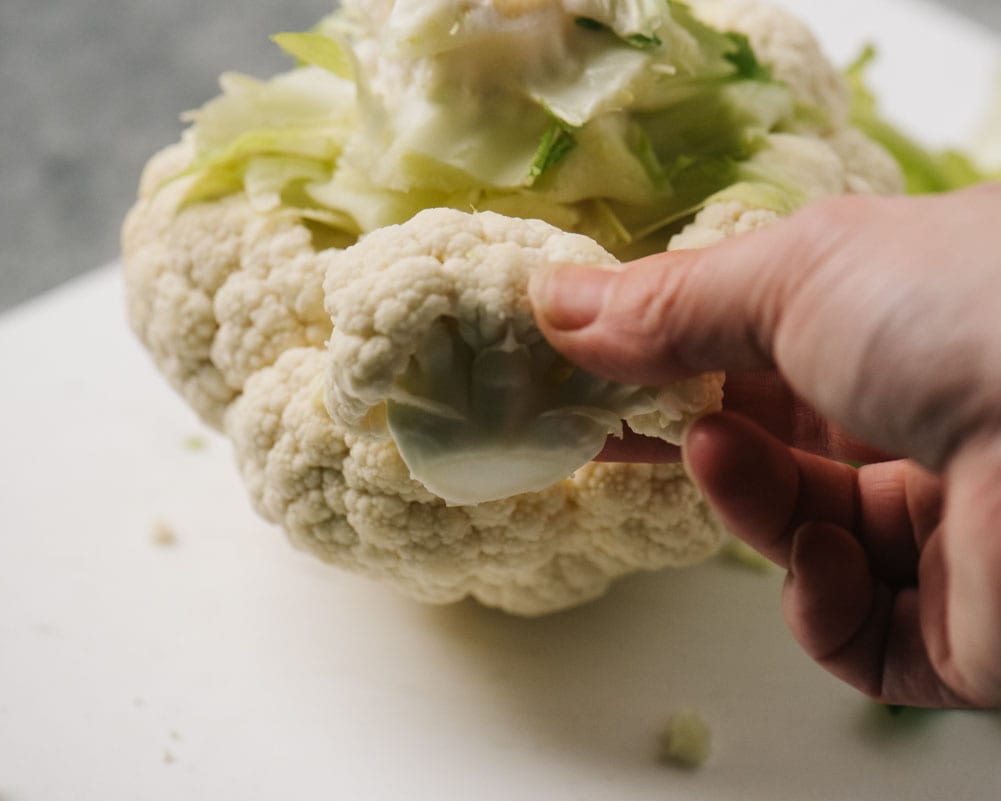
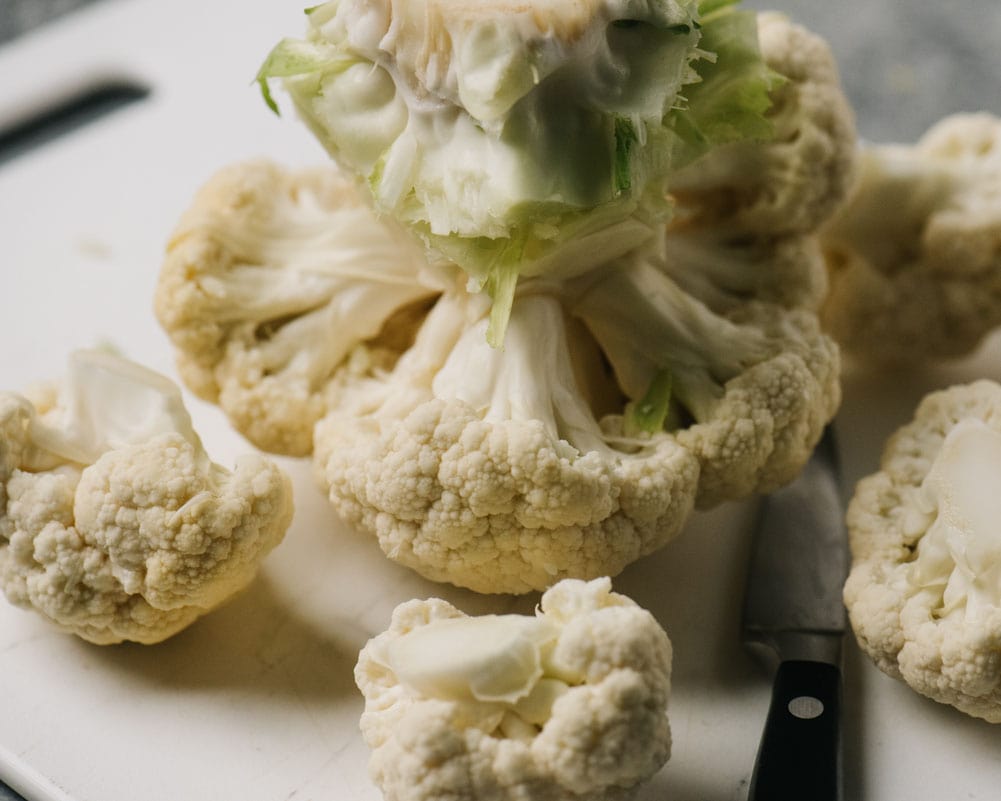
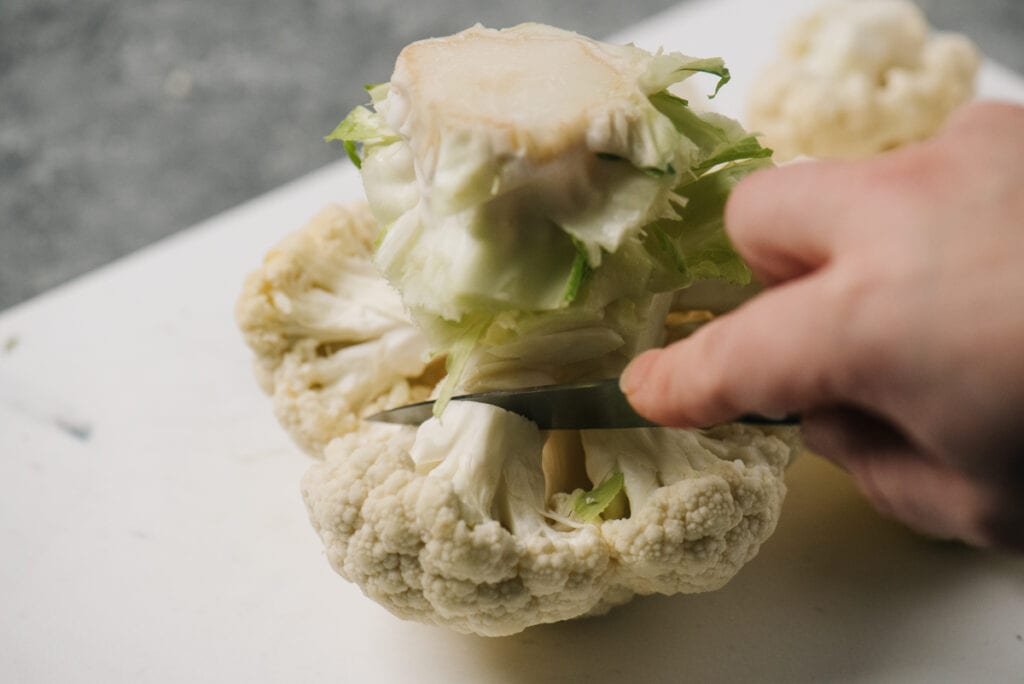
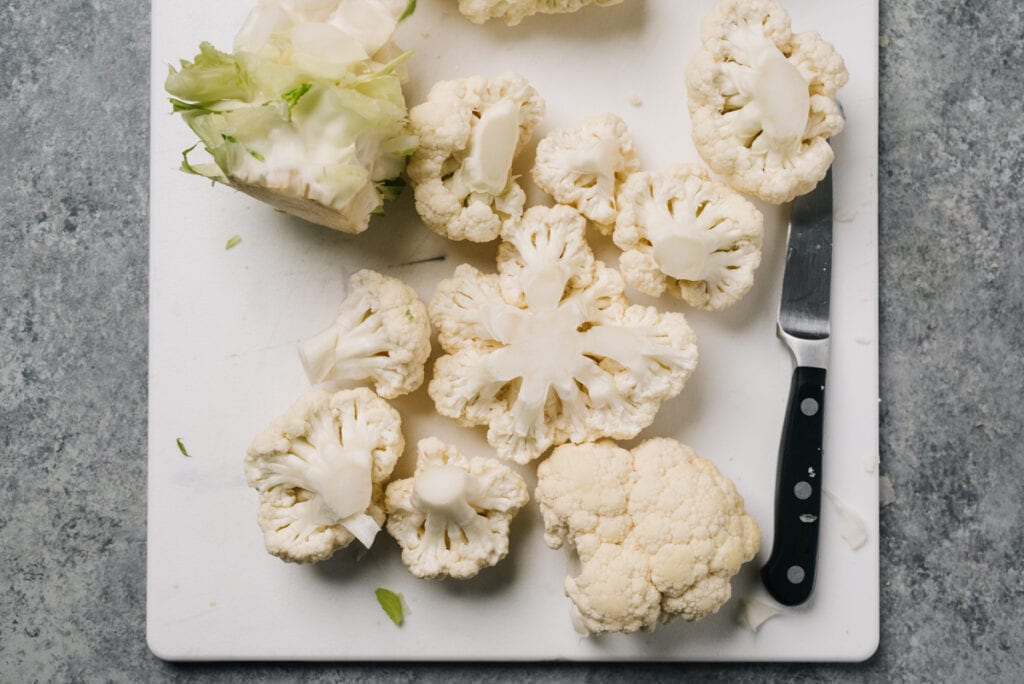
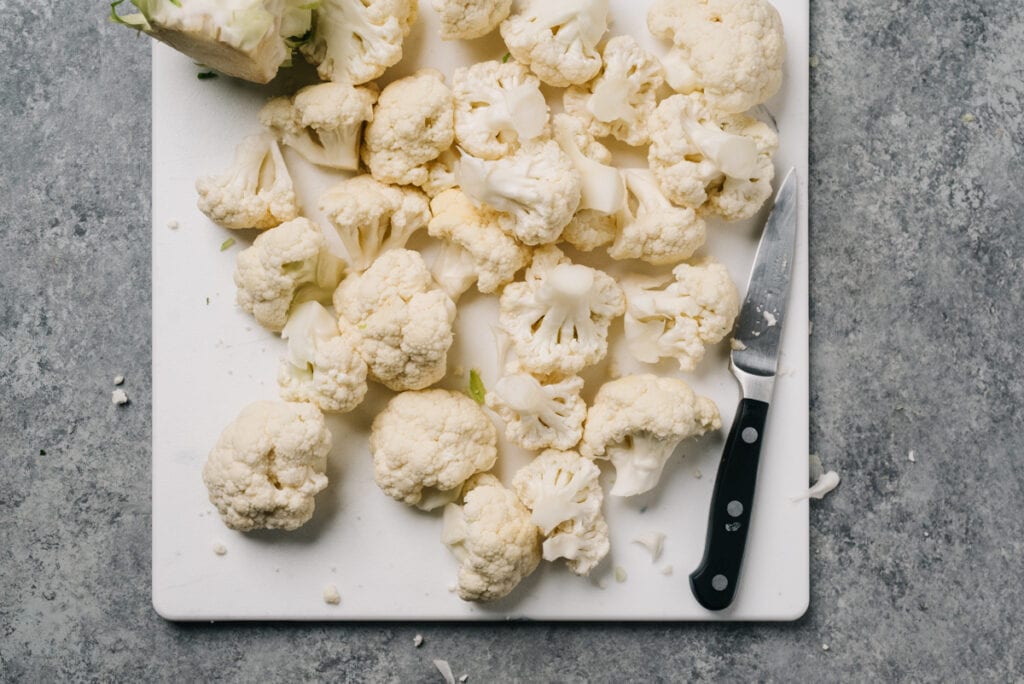
- Remove the leaves by breaking them off or cutting away with a paring knife.
- Place the head of cauliflower on a cutting board stem side up.
- Use a paring knife to cut away a single floret from the base of the stem.
- Continue working around the base of the stem and use the paring knife to remove the largest florets around the base.
- Continue working your way around the core, slicing off cauliflower florets, until you are left with a small cluster from the “top” and “center” of the head of cauliflower.
- Trim the florets to preferred size. To do so, slice into the stem until you reach the floret, then break apart to prevent crumbling.
Oven Roasted Cauliflower
In this chef’s humble opinion, roasted cauliflower is the gold standard of cooked cauliflower. It’s the high bar. The Cadillac. The Champagne. The transformation cauliflower goes through in the oven isn’t just chemical, it’s alchemical. Crispy, caramel crusted edges give way to a buttery bite that practically melts in your mouth. Food this good shouldn’t be this simple. Achieving the magic requires the right amount of oil, the right temperature, and plenty of breathing room.
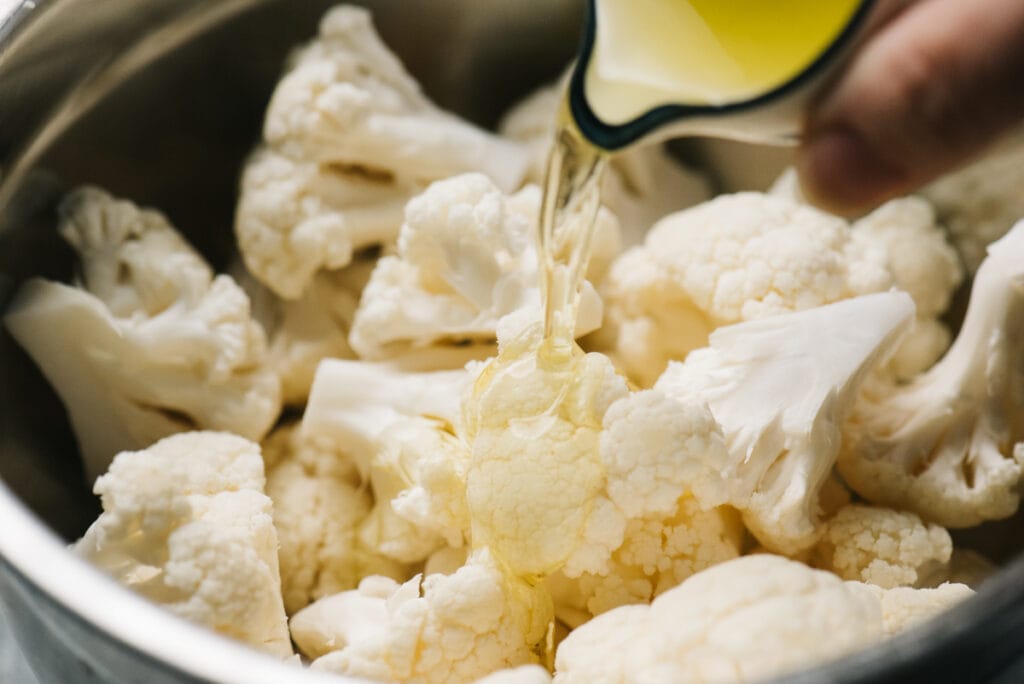
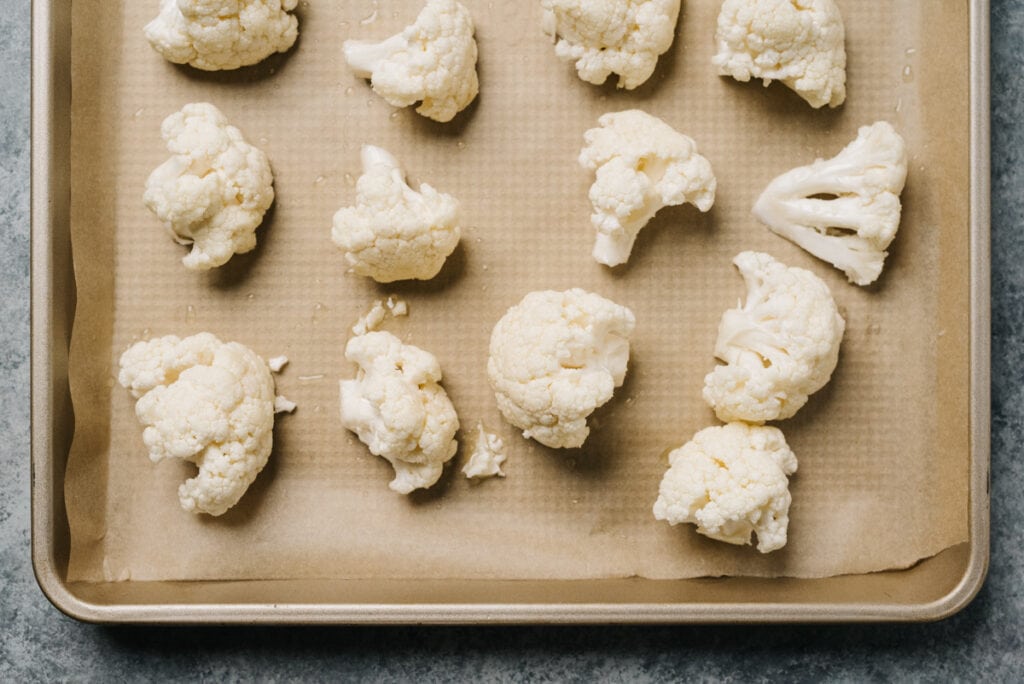
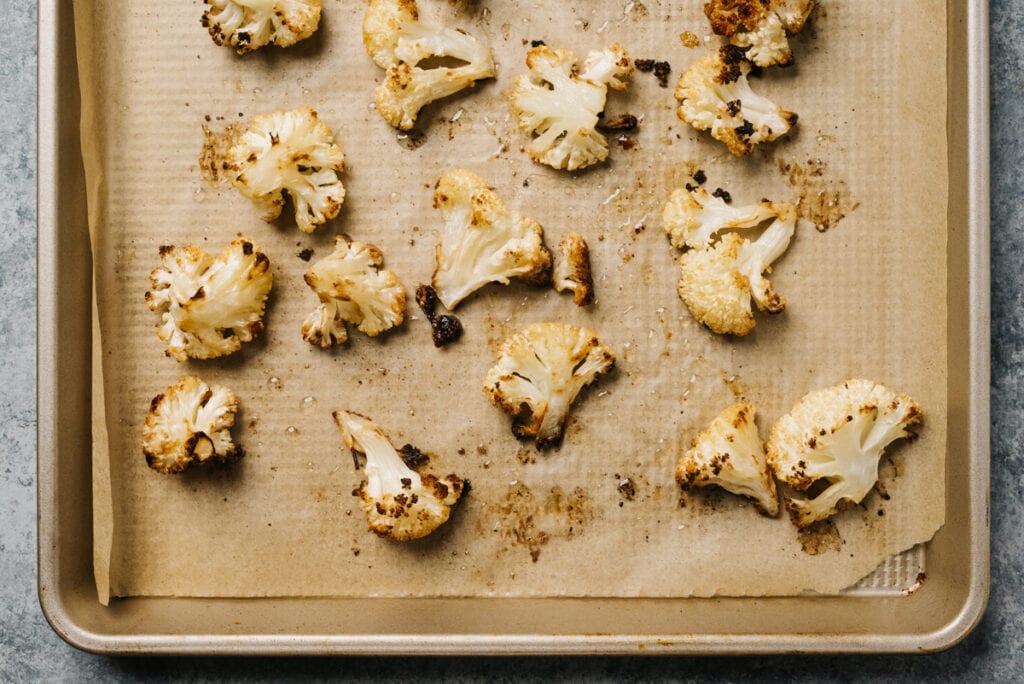
- Combine cauliflower florets with olive oil, salt, pepper and additional seasonings (see the recipe card for suggestions) in a large bowl. Toss until well combined. Pro-tip: you need more oil than you think! 3-4 tablespoons for an average head (about 6 cups of florets) will ensure crispy, well-seasoned florets.
- Spread the florets onto a parchment lined baking sheet in a single layer, leaving a bit of room between each one.
- Roast in 425°F degree oven for 30-35 minutes for small florets, or 40-45 minutes for large florets. Flip the florets once halfway through roasting – they’ll cook more evenly. I like to use a fish spatula for this kind of “delicate” vegetable work.
- Remove from the oven and serve immediately.
We love roasted cauliflower! For more inspiration, see our recipes for parmesan roasted cauliflower, spiced roasted cauliflower, and mediterranean roasted cauliflower.
Serving Roasted Cauliflower (Oven or Air Fryer)
- As is! My children will gladly eat florets simply roasted with olive oil and salt.
- Dress it up with romesco sauce or pesto.
- Add to pasta – nutty roasted cauliflower pairs well with creamy pasta sauce.
- Roasted cauliflower is an incredible base for soup. Add a head of garlic to the baking sheet, then make roasted cauliflower soup.
Air Fryer Cauliflower
Air Fryer Cauliflower is fast, easy, and super satisfying. These nutty, crispy cauliflower florets are never greasy or soggy and cook to tender perfection in under 20 minutes. When you’re craving roasted cauliflower but need it fast, the air fryer delivers. Toss with olive oil, season, and “fry” away – just don’t forget to stir ’em up often.


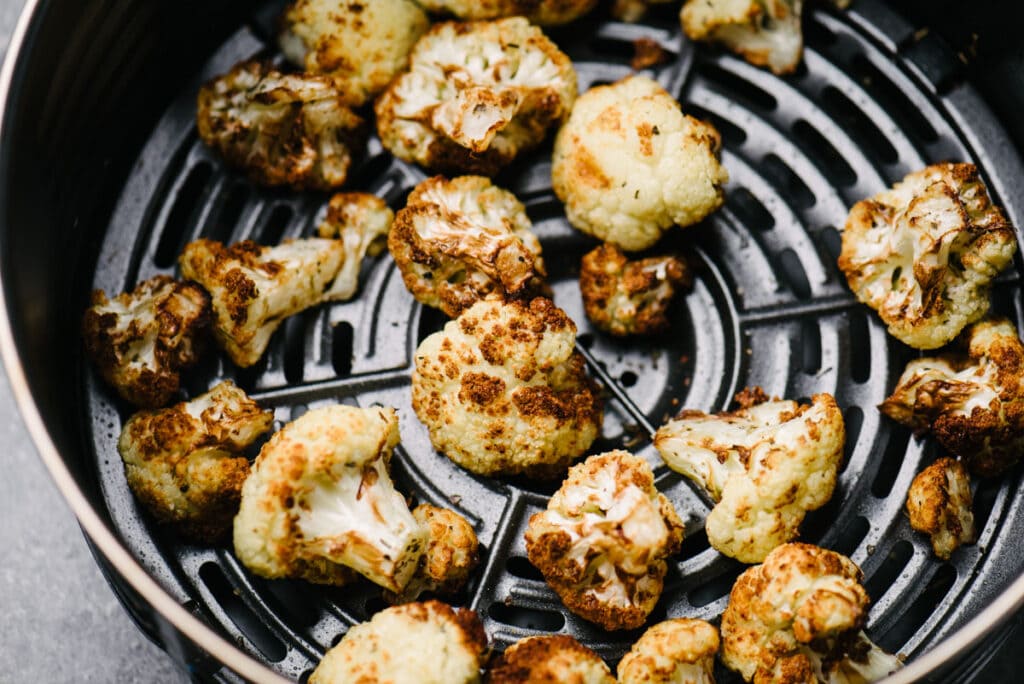
- Combine cauliflower florets with olive oil, salt, pepper and additional seasonings (see the recipe card for suggestions) in a large bowl. Toss until well combined.
- Transfer to the basket of your air fryer and arrange in a single, even layer.
- Cook at 390°F for 12 minutes, tossing every 4-6 minutes.
- Serve warm, right away. Enjoy!
Sautéed Cauliflower
What sautéed cauliflower lacks in caramelization, it makes up for in ease. Stovetop cooking will give you a beautiful golden brown color in about a quarter of the time. Bonus: since you’re losing less moisture than in the oven, you get a bigger, meatier bite. Added bonus: stir fried cauliflower is prime for saucing and soaks up flavor while keeping the buttery, nutty undertones.
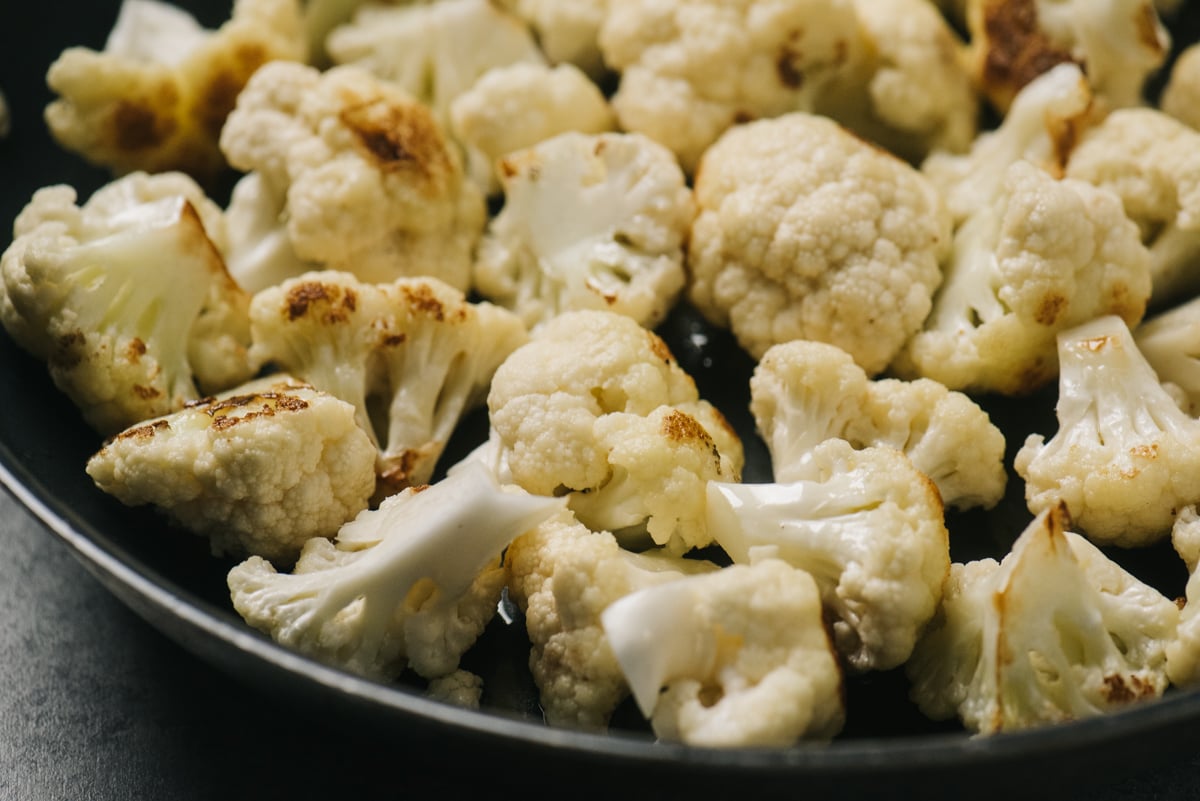
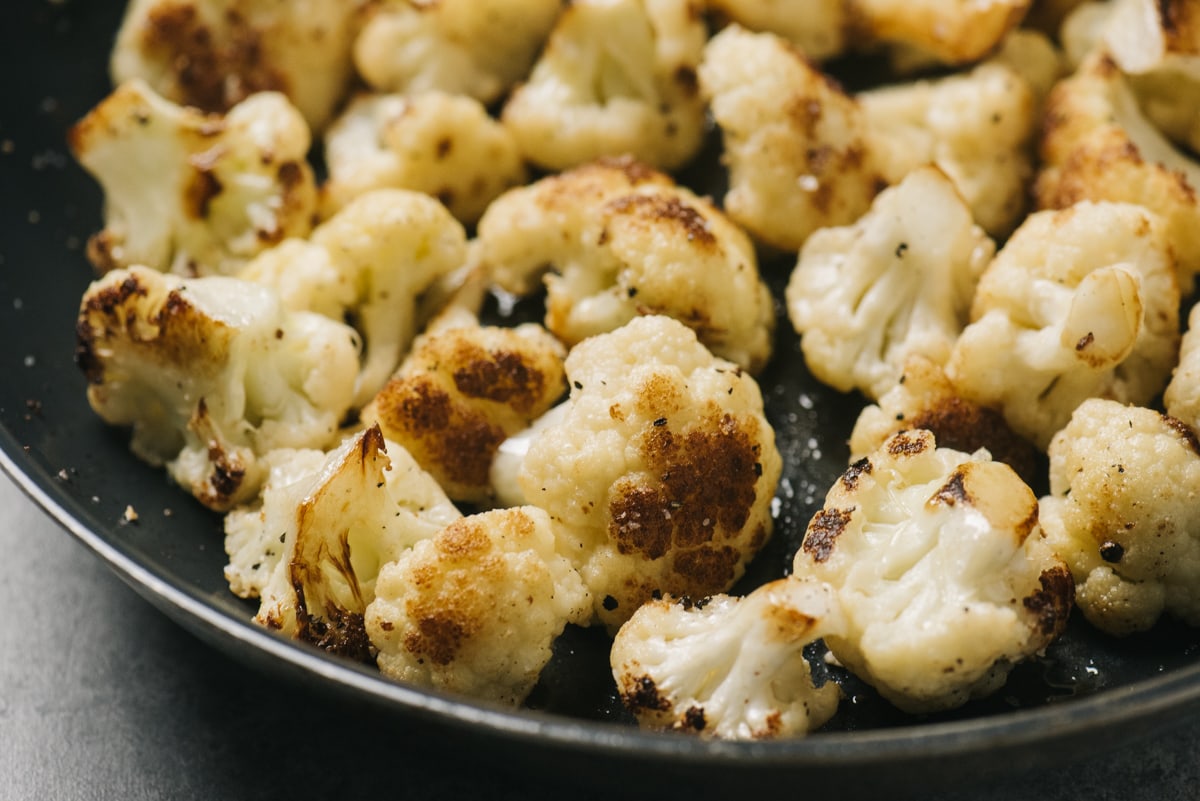
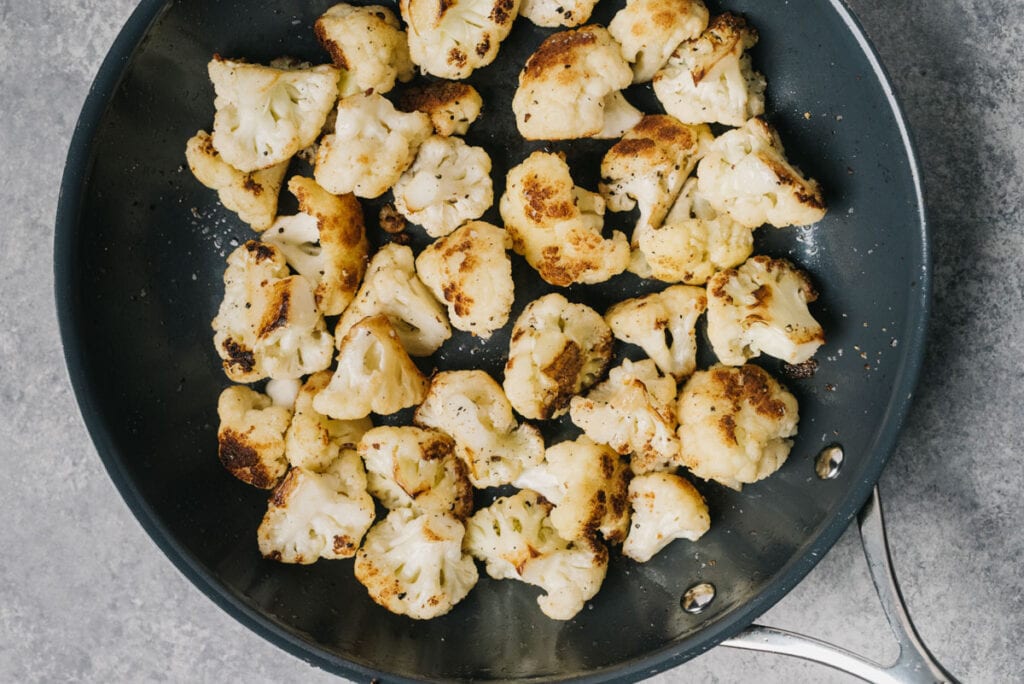
- Heat olive oil in a large 12″ skillet or wok.
- Add the cauliflower florets, toss to coat in the fat, then shake the pan until the florets land in a single, even layer. Saute undisturbed for 3 minutes. Stir the florets, then saute another 3 minutes undisturbed.
- Pour in 2 tablespoons of water, then cover the skillet and cook for 3 minutes.
- Remove the cover and sauté 1-2 minutes more, stirring constantly, or until the cauliflower is golden brown and all moisture has been evaporated.
- Season with salt and pepper, and serve right away.
Sautéed Cauliflower Variations
- Add ⅓ cup of all purpose stir fry sauce in Step 4, toss, then cook until the sauce slightly thickens, 2-3 minutes more – serve with rice for a quick vegan lunch. Or, try our cauliflower stir fry with shiitake mushrooms!
- Add 1 teaspoon sesame oil along with the olive oil and stir fry as directed. Garnish with sesame seeds and sliced green onions for an Asian-inspired side dish.
Instant Pot Cauliflower
If you’re having childhood flashbacks of soggy, limp cauliflower that’s somehow both sulfurous and flavorless, then let this steaming method wash those memories away. Instant Pot cauliflower is great on its own, lightly seasoned with butter, lemon, and/or parmesan cheese.
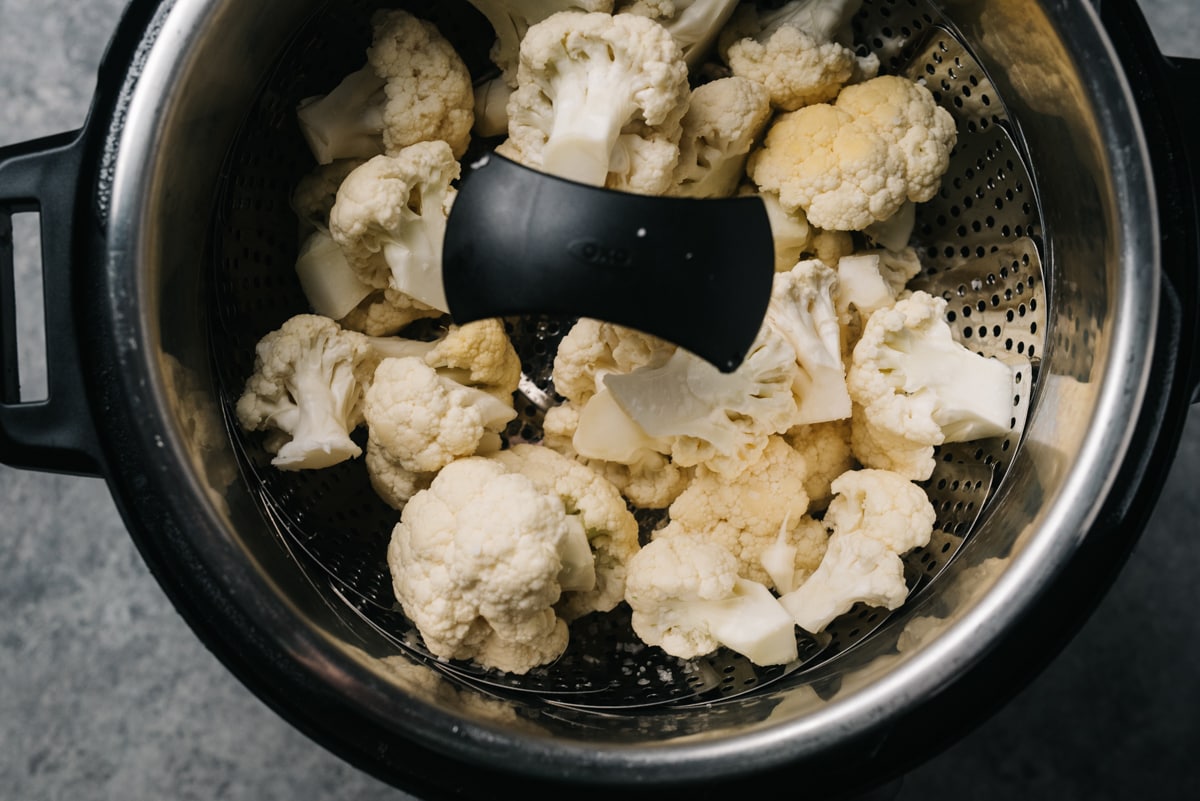
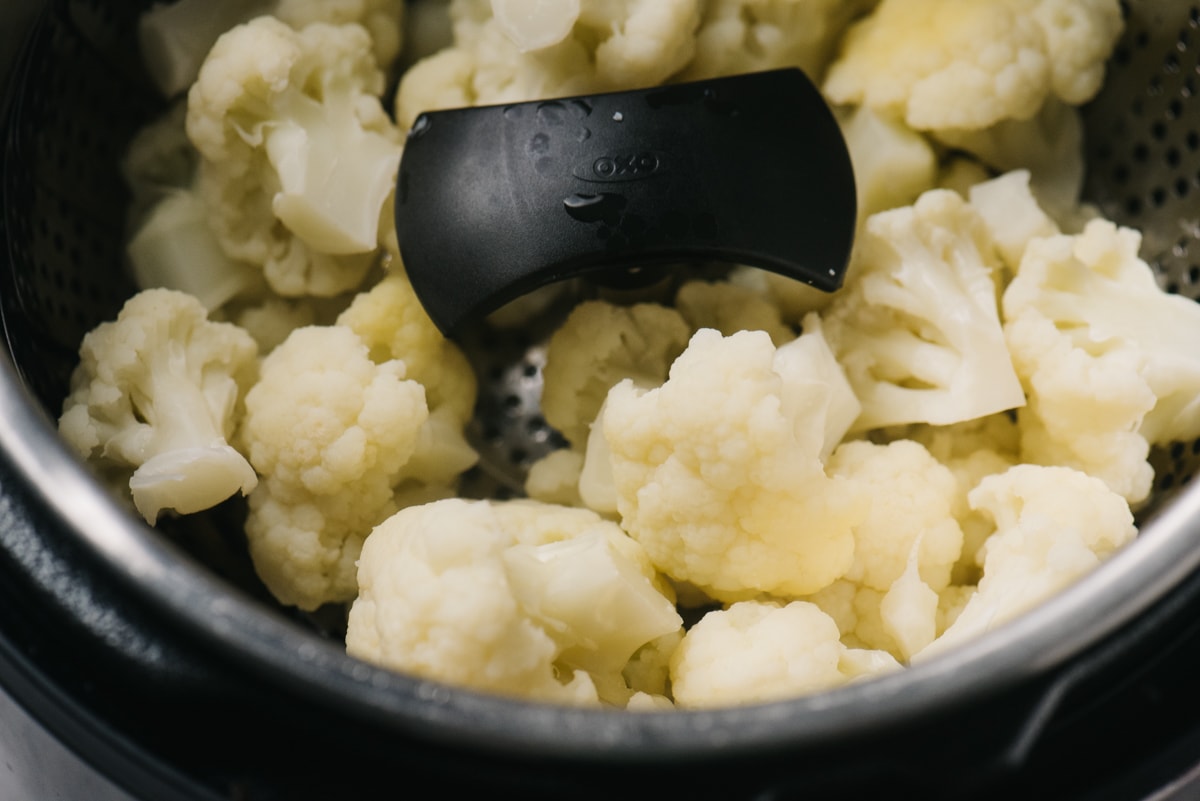
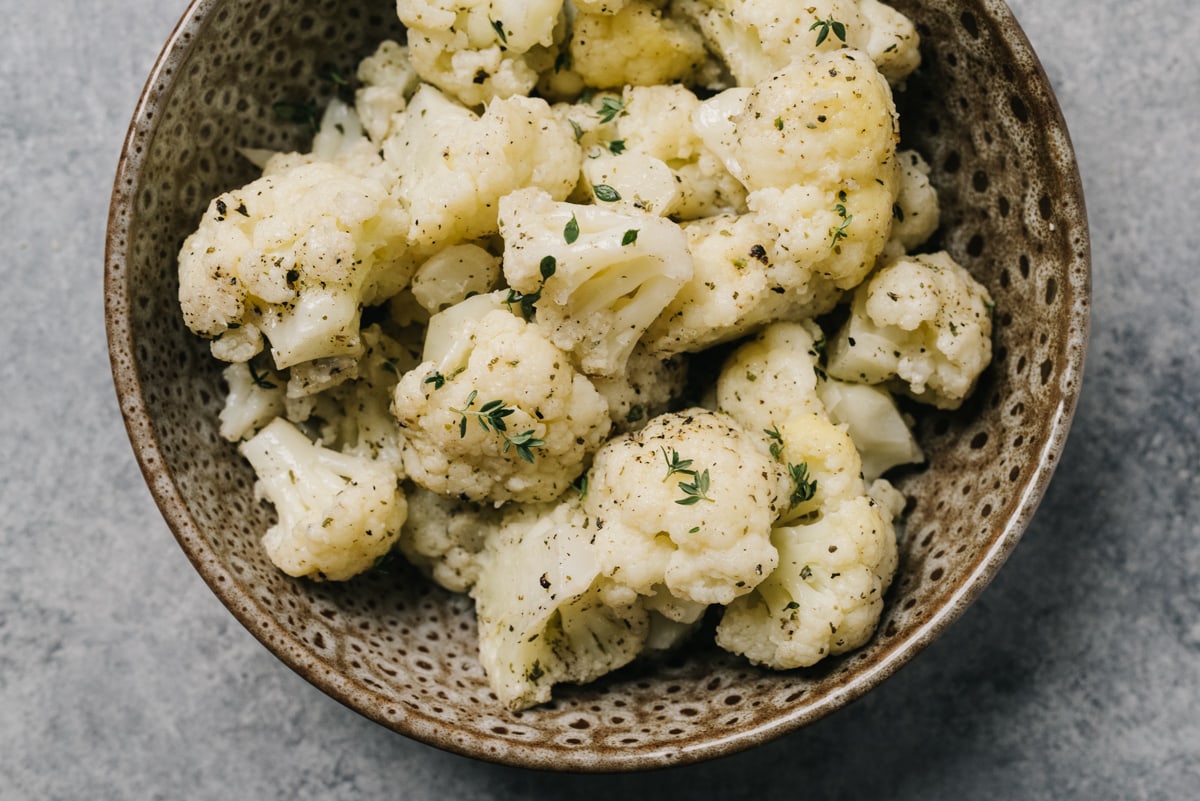
- Place a steamer basket into the inner pot of an Instant Pot along with ½ cup water.
- Arrange the cauliflower in the steamer basket, then sprinkle with salt.
- Cook on HIGH pressure for 3 minutes for crisp tender florets, or 4 minutes for soft, mashable florets.
- Release the pressure manually, then remove the steamer basket.
- Season with olive oil or melted butter, salt, pepper, and other seasonings as desired. Serve warm, right away.
Microwave Cauliflower
As if steaming cauliflower couldn’t get any simpler, tender steamed cauliflower is ready to serve in just 5 minutes from the microwave!
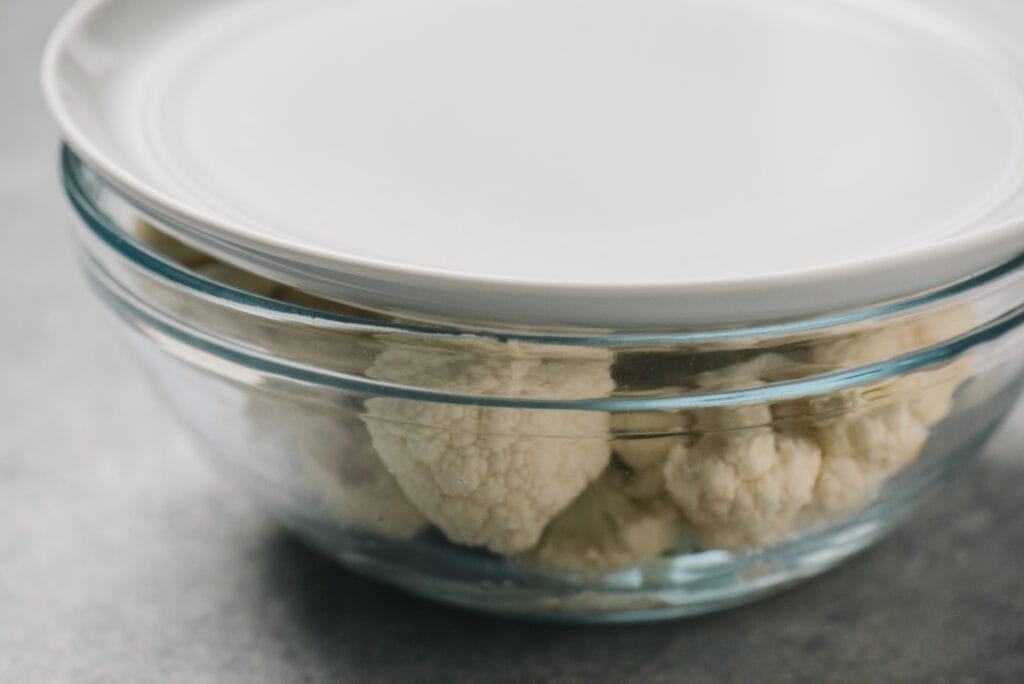
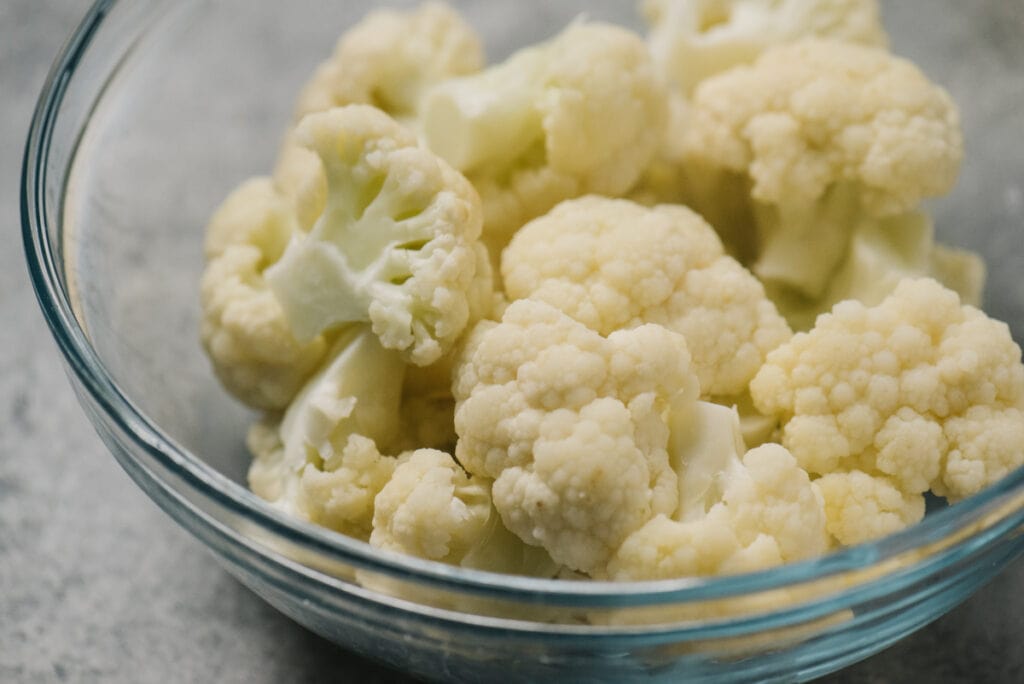
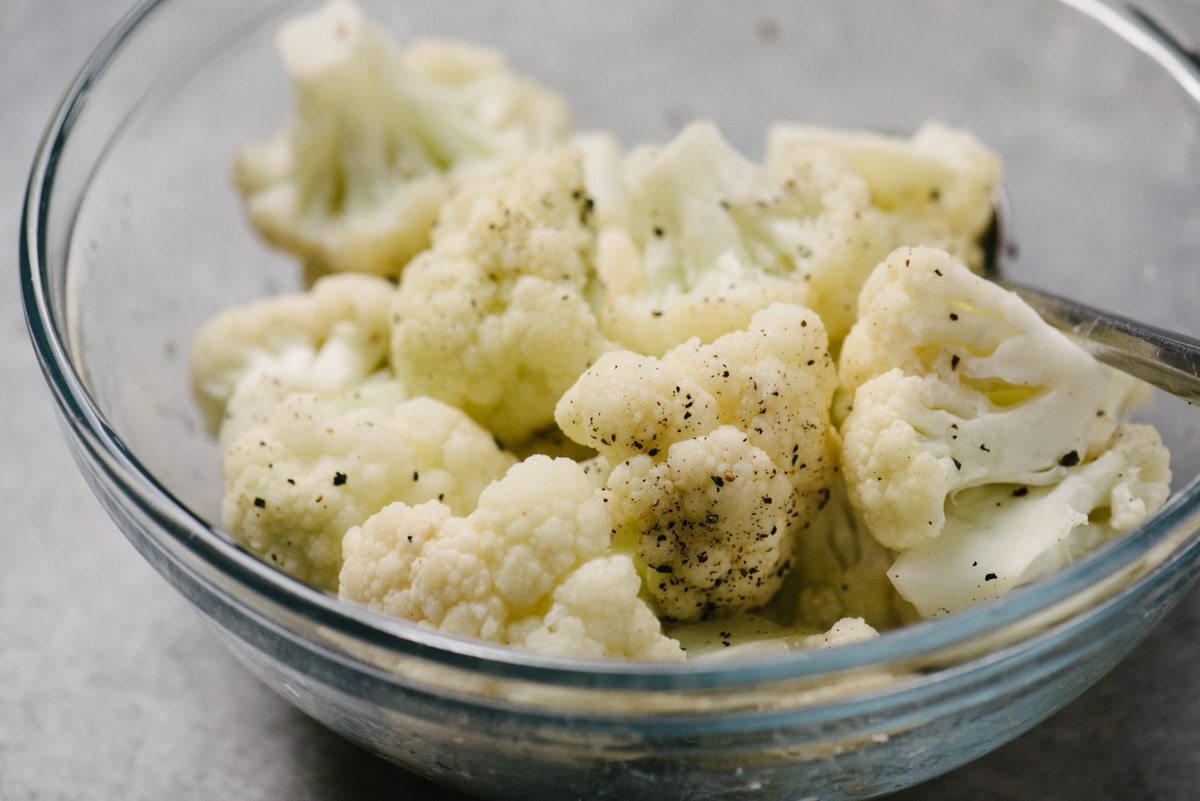
- Combine cauliflower florets and ¼ cup water in a microwave safe bowl.
- Cover with a plate and transfer to the microwave. Microwave for 5 minutes for crisp tender florets.
- Strain the residual water.
- Season with olive oil or melted butter, salt, pepper, and other seasonings as desired. Serve warm, right away.
Steamed Cauliflower
Grab your steamer basket for classic Steamed Cauliflower. With the proper time, technique, and seasonings, steaming cauliflower makes for a super-duper super simple side dish. Fork-tender florets are ready on the stovetop in under 10 minutes.
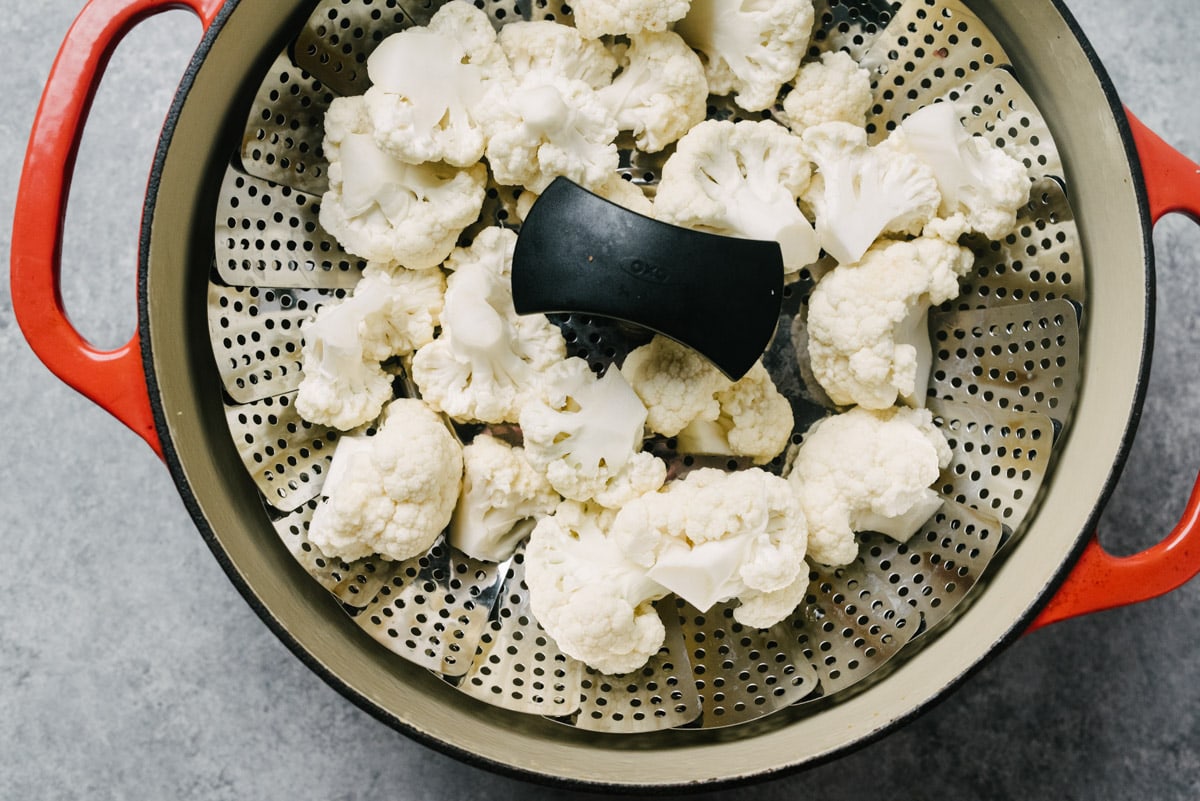
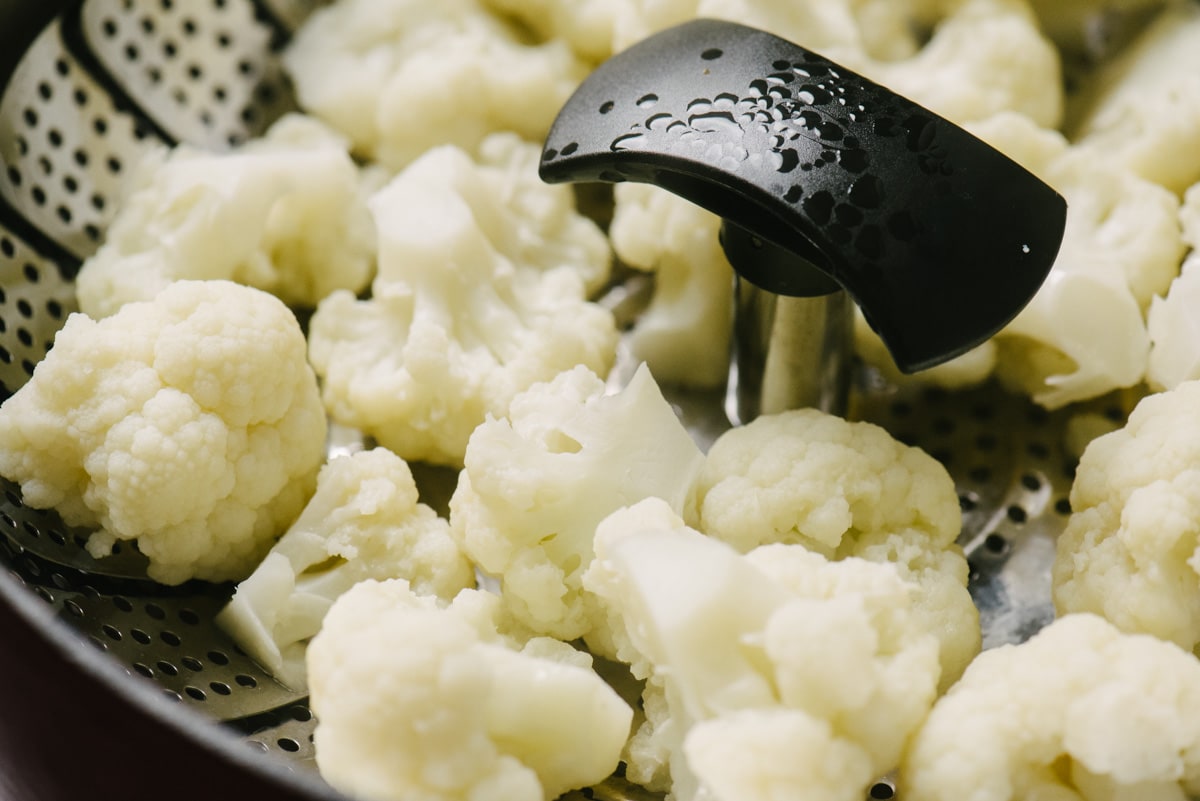
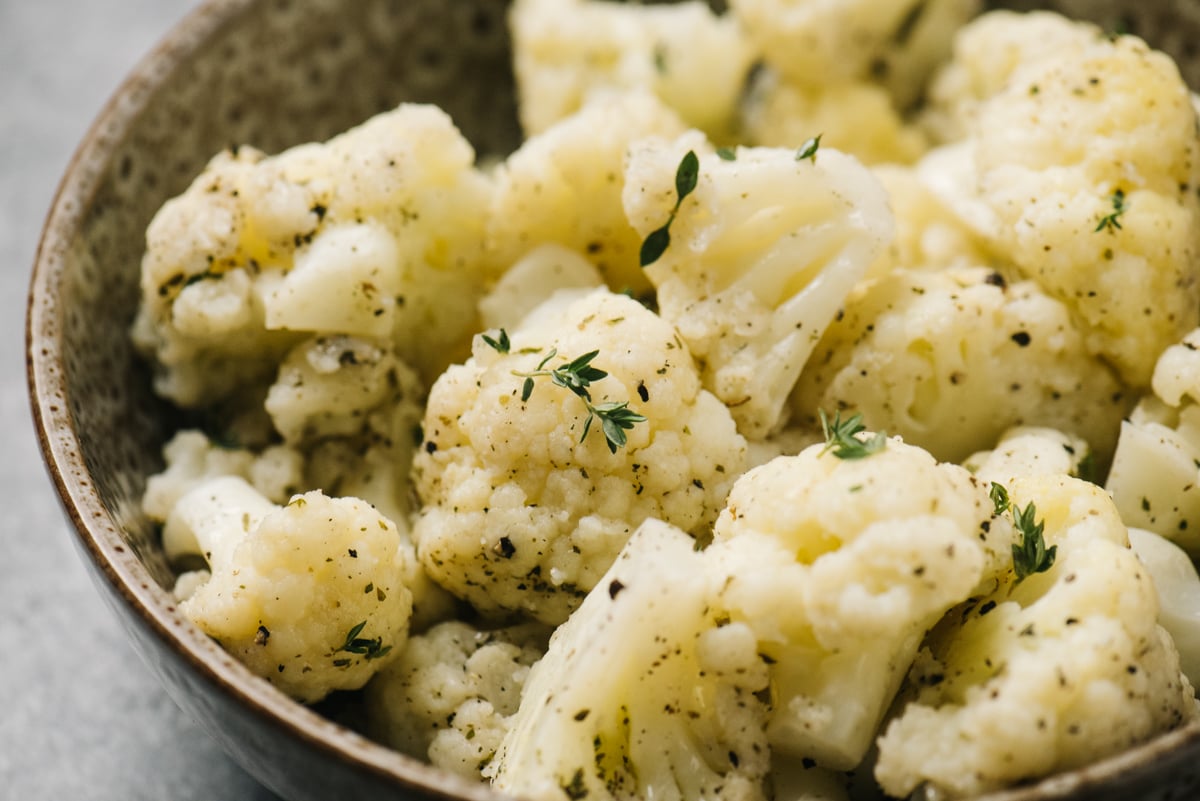
- Fill a dutch oven or other appropriate pot with 2″ water, then fit a steamer basket into the pot.
- Bring the water to a boil over high heat.
- Add the cauliflower florets to the steamer basket, along with a pinch of salt.
- Reduce the heat to low to maintain a simmer, then cover and steam 5-6 minutes for crisp tender florets.
- Transfer the steamed cauliflower to a bowl and toss with olive oil or melted butter, salt, pepper, and other seasonings as desired. Serve warm, right away.
Serving Steamed Cauliflower (Instant Pot, Microwave, or Stovetop)
- Basic: toss with melted butter or extra virgin olive oil, salt, and pepper.
- Mediterranean: toss with extra virgin olive oil, the zest and juice of one lemon, 1 teaspoon Italian seasoning – or 1 tablespoon fresh chopped herbs (basil, thyme, parsley) – and finely grated parmesan cheese to taste.
- Italian: tossed with toasted bread crumbs, browned butter, and chopped fresh basil or parsley.
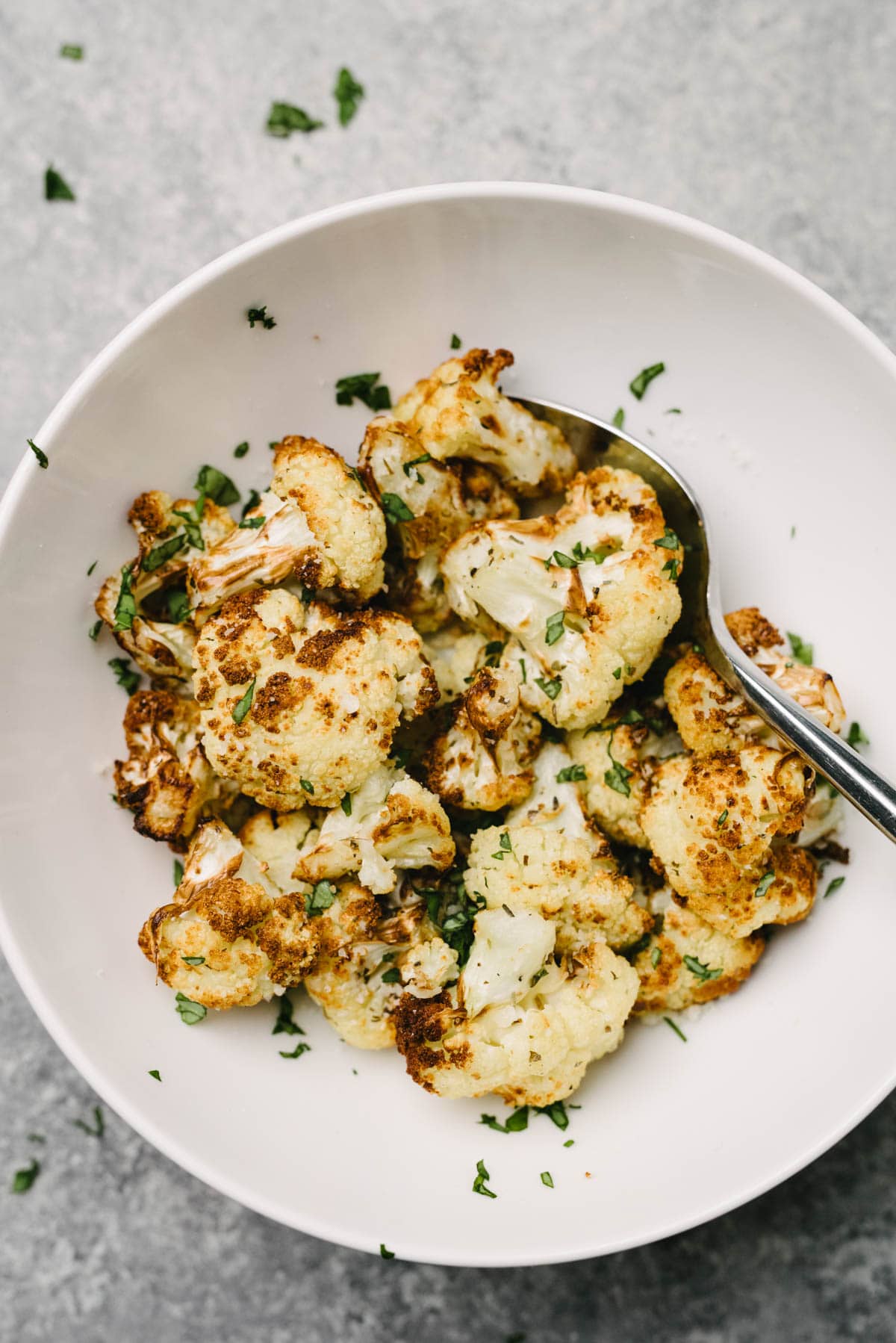
Craving More Cauliflower?
Now that you know how to cook cauliflower like a total pro, get ready for a new adventure! There are so many ways to enjoy fresh cauliflower, but these are some of our favorites:
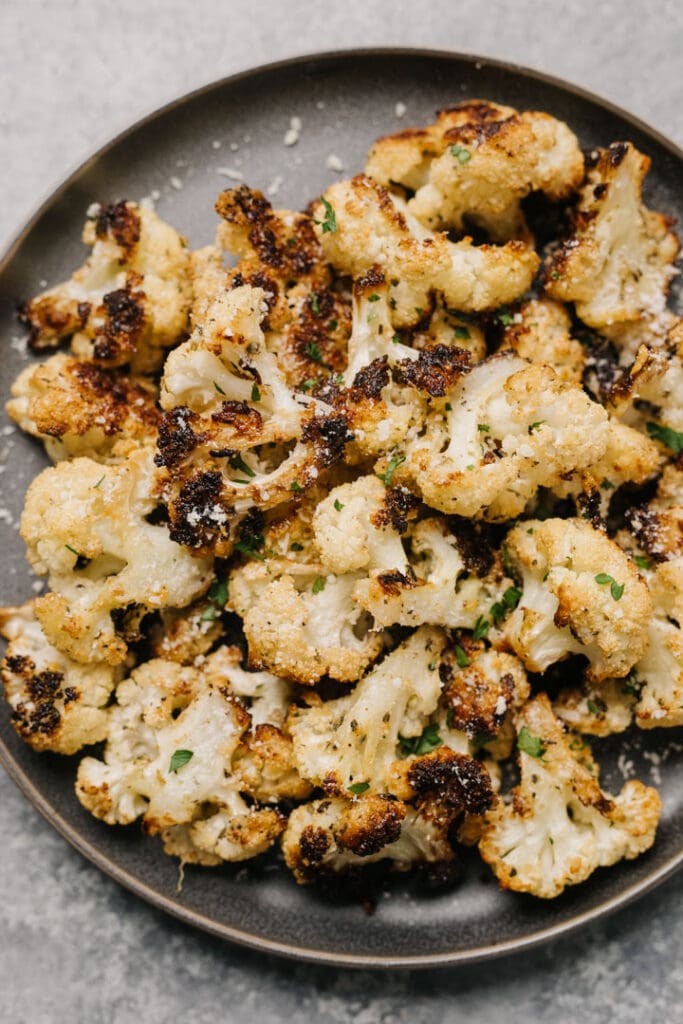
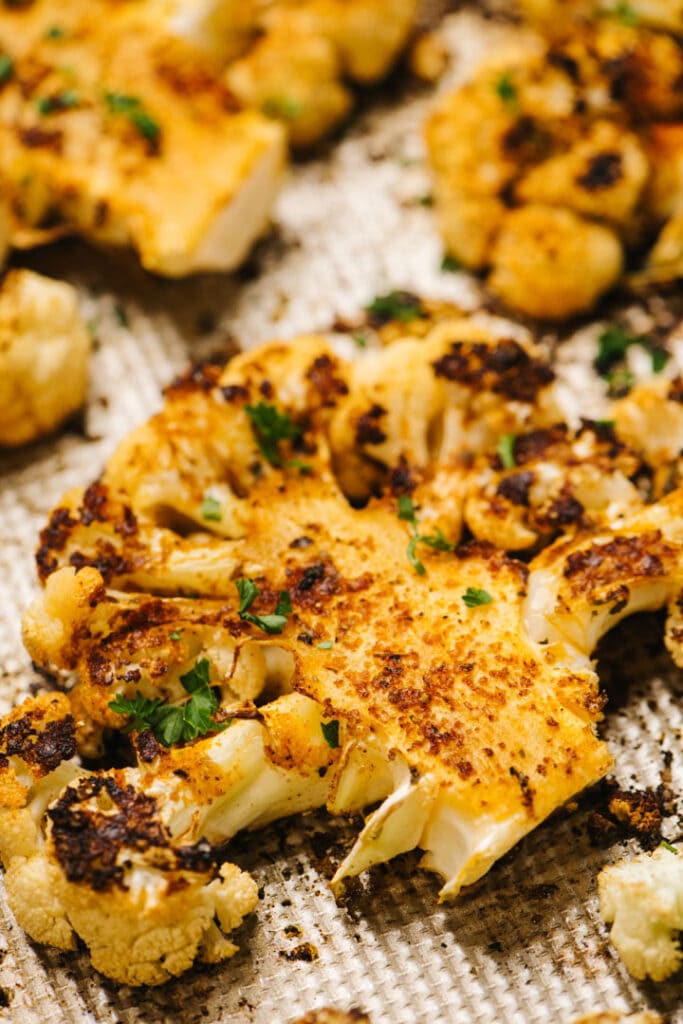
- Soups: transform roasted cauliflower florets into creamy, dreamy roasted cauliflower soup or subtly spiced curried cauliflower soup with just a few extra steps. Simmer cauliflower with bacon and vegetables to make a low carb and flavor-packed loaded cauliflower soup.
- Go Extra: simple roasted cauliflower is very, very good, but it can be better! Parmesan roasted cauliflower is our family’s favorite side dish – we make it at least once a week! If you’re a fan of flavor in every nook and cranny, try roasted cauliflower steaks.
- Holiday Style: I always incorporate cauliflower into our holiday sides, because it’s a vegetable both my kids will eat without complaint – especially if it’s smothered in cheese sauce, like in our creamy cauliflower au gratin.
- Make It the Star: there’s not need to keep cauli in the corner! Make it the star of the show in cauliflower shawarma grain bowls, cauliflower curry, or cauliflower stir fry.
- Rice, Rice Baby!: if you’re learning to love cauliflower for dietary reasons, you’re going to want to master cauliflower rice. Our starter guide includes everything you need to know about how to make cauliflower rice plus tons of ways to dress it up.


What’s your favorite way to cook cauliflower? Tell me all about it in the comments section below!
While you’re at it, let’s be friends – follow me on Pinterest and Instagram for the latest and greatest.
Recipe
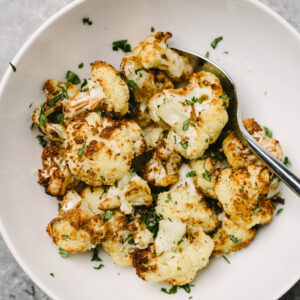
How to Cook Cauliflower
Print Recipe Rate this Recipe Pin RecipeIngredients
- 1 medium head cauliflower, divided into florets (about 6 cups)
- 2-4 tablespoons olive oil, or melted butter
- 1 teaspoon kosher salt
- ½ teaspoon ground pepper
- water, as needed, depending prep method; see instructions
To Garnish
- lemon juice, to taste
- finely grated parmesan cheese, to taste
- minced fresh herbs, such as parsley, basil, and/or thyme
Instructions
Roasted Cauliflower
- Heat the oven to 425°F with a rack positioned in the bottom third. Line a baking sheet with parchment paper.
- Divide the cauliflower into florets, then transfer to a large mixing bowl. Add ¼ cup olive oil, salt, pepper, and optional seasonings (if using), then toss until the florets are evenly coated with oil and seasonings.
- Arrange the cauliflower on the prepared baking sheet in a single, even layer, leaving a bit of space between each floret.
- Transfer to the oven and roast for 20 minutes. Remove the baking sheet, flip over the florets, then return to the oven and roast an additional 15-20 minutes, depending on the size of the florets. The cauliflower is ready once golden brown all around the edges and the stems are tender; you should be able to insert the tip of a paring knife into the stem and meet little resistance.
- Serve hot, right away. Enjoy!
Air Fryer Cauliflower
- Toss cauliflower florets with 2 tablespoons olive oil, salt, and pepper (and other seasonings as desired, see notes) in a large bowl until well combined.
- Spread into an even layer in the basket of the air fryer. Do not fill the basket more than halfway full, but for best results, aim for a single layer.
- Program to 390°F for 12 minutes. Remove the basket and toss at least once halfway through, but preferably every 4 minutes. (You can also program in 4-6 minute increments as a more firm reminder to toss). If the cauliflower isn’t cooked through, program an additional 2-3 minutes (smaller florets will cook more quickly).
- Sprinkle with fresh herbs (we like basil and/or parsley) and serve right away. Enjoy!
Sautéed Cauliflower
- Heat a 12” skillet over medium high heat. Add ¼ cup of olive oil and heat until it shimmers. Add the cauliflower, toss to coat in the fat, then arrange in a single layer. Sear, undisturbed, for 3 minutes. Toss the cauliflower, then sear an additional 3 minutes undisturbed.
- Pour in 2 tablespoons of water, then cover the skillet. Cook covered for 3 minutes. Remove the lid then cook 1-2 minutes more, stirring continuously, or until the water has evaporated and the florets are tender and golden brown.
- Season with salt and pepper, and serve warm right away.
Instant Pot Cauliflower
- Pour ½ cup water into the inner pot. Position a trivet or all metal steamer basket in the pot. Place the florets into the steamer basket, then sprinkle with ½ teaspoon kosher salt.
- Secure the lid and ensure the pressure valve is set to Sealing. Program to High Pressure 3 minutes for crisp tender florets. It will take approximately 10 minutes for the pot to come to pressure.
- Once the timer goes off, press the Cancel button to turn off the Instant Pot. Then perform a manual pressure release by turning the venting knob from Sealing to Venting. Once the float valve has dropped, open the lid away from your body to allow the steam to escape. Carefully remove the steamer basket with oven mitts, or remove the florets with a slotted spoon.
- Transfer the florets to a bowl and toss with 2 tablespoons olive oil or melted butter, an additional ½ teaspoon of kosher salt, and ½ teaspoon ground pepper. Serve warm, right away. Enjoy!
Microwave Cauliflower
- Place the florets into a microwave safe bowl then sprinkle with ½ teaspoon kosher salt. Add ¼ cup water, then cover the bowl with a plate.
- Microwave 5 minutes for crisp tender florets.
- Strain the cauliflower from the steaming water. Drizzle with 2 tablespoons olive oil or melted butter, an additional ½ teaspoon of kosher salt, and ½ teaspoon ground pepper. Serve warm, right away. Enjoy!
Steamed Cauliflower
- Fill a pot large enough to accommodate a steamer basket with 2” water. Position the steamer basket in the pot, then bring the water to a simmer over high heat.
- Place the florets into the steamer basket, then sprinkle with ½ teaspoon kosher salt. Reduce the heat to medium low to maintain a steady simmer, then cover.
- Steam 5-6 minutes for crisp tender florets.
- Remove the florets using a slotted spoon and transfer to a bowl. Drizzle with 2 tablespoons olive oil or melted butter, an additional ½ teaspoon of kosher salt, and ½ teaspoon ground pepper. Serve warm, right away. Enjoy!
Notes
- Italian: add 1 teaspoon Italian seasoning along with the olive oil, salt and pepper. After roasting, garnish with lemon zest and finely shredded parmesan cheese.
- Mexican: add ½ – 1 teaspoon red pepper flakes and 1 teaspoon cumin along with the olive oil and salt; omit the pepper. After roasting, season with the zest and juice of 1 lime.
- Indian: add 1 teaspoon cumin and 1 teaspoon turmeric along with the olive oil, salt, and pepper. Garnish with chopped fresh cilantro.
- Mediterranean: after roasting, toss with the juice and zest of 1 lemon, ¼ cup toasted pine nuts, and 2 tablespoons chopped fresh parsley.
- Add ⅓ cup of all purpose stir fry sauce in Step 4, toss, then cook until the sauce slightly thickens, 2-3 minutes more.
- Add 1 teaspoon sesame oil to the olive oil and saute as directed. Garnish with sesame seeds and sliced green onions for an Asian-inspired side dish.
- Mediterranean: Toss cooked cauliflower with 2 tablespoons extra virgin olive oil, the zest and juice of one lemon, 1 teaspoon Italian seasoning or 1 tablespoon fresh chopped herbs (basil, thyme, parsley), and finely grated parmesan cheese to taste.
- Italian: Toss with ¼ cup toasted bread crumbs, 2 tablespoons browned butter, and 2 tablespoons chopped fresh basil or parsley.


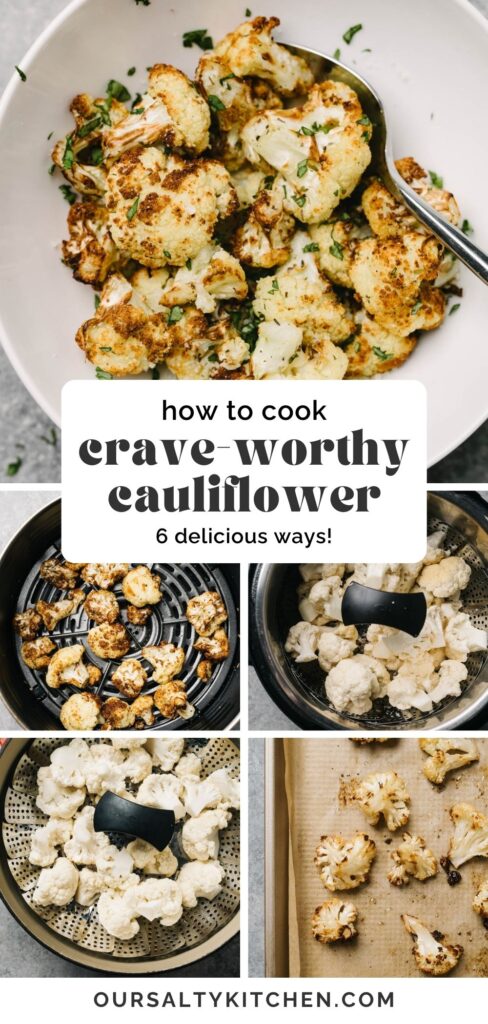
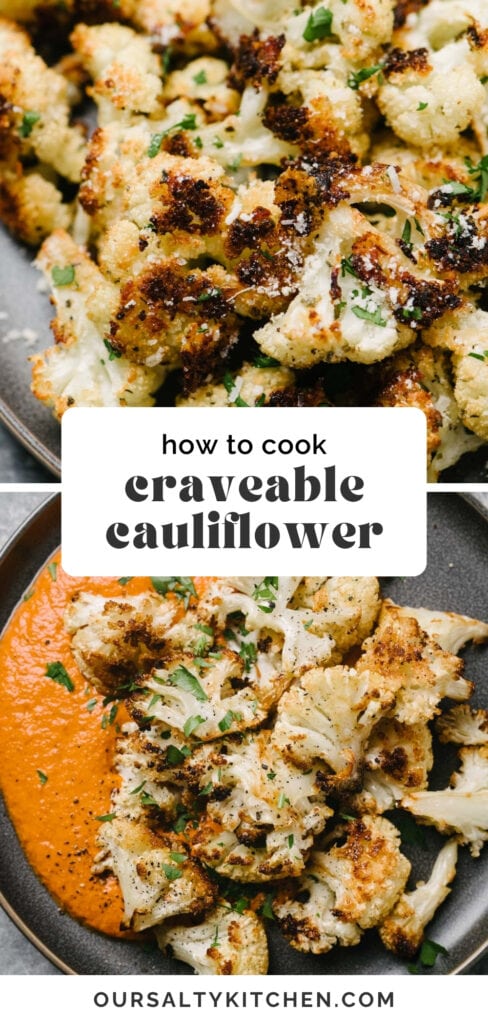

Trinity
Worked out perfectly!